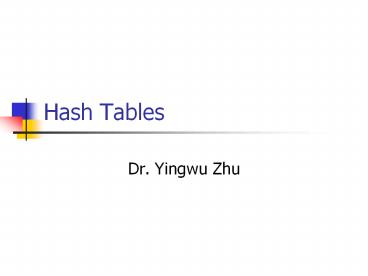Hash%20Tables - PowerPoint PPT Presentation
Title:
Hash%20Tables
Description:
Hash Tables Dr. Yingwu Zhu – PowerPoint PPT presentation
Number of Views:122
Avg rating:3.0/5.0
Title: Hash%20Tables
1
Hash Tables
- Dr. Yingwu Zhu
2
Hash Tables
- Recall order of magnitude of searches
- Linear search O(n)
- Binary search O(log2n)
- Balanced binary tree search O(log2n)
- Unbalanced binary tree can degrade to O(n)
3
Hash Tables
- Sometime faster search is needed
- Solution use hashing
- Value of key field fed into a hash function
- Location in a hash table is calculated
4
Hashing
- Key to hashing
- The hash function h(x)
5
Hash Functions
- Simple function could be to mod the value of the
key by some arbitrary integerint h(int
i) return i someInt - Note the max number of locations in the table
will be same as someInt - Note that we have traded speed for wasted space
- Table must be considerably larger than number of
items anticipated
6
Hash Functions
- Observe the problem with same value returned by
h(i) for different values of i - h(i) i mod 31
- Called collisions
- A simple solution is linear probing
- Linear search begins atcollision location
- Continues until emptyslot found for insertion
7
Hash Functions
- When retrieving a valuelinear probe until found
- If empty slot encounteredthen value is not in
table - If deletions permitted
- Slot can be marked soit will not be empty and
cause an invalid linear probe
8
Hash Functions
- Strategies for improved performance
- Increase table capacity (less collisions)
- Use a different collision resolution technique
- Devise a different hash function
9
Hash Table Capacity
- Size of table must be 1.5 to 2 times the size of
the number of items to be stored - Otherwise probability of collisions is too high
- Sometimes may be hard to get the estimate of the
number of items
10
Collision Strategy
- h(x) x 31, the hash table has size of 31
- Insertion order of 620, 64, 128, 467, 777, 35,
127, 282 - Exercise Use linear probing to solve collision
11
Collision Strategy
- Linear probing can result in primary clustering
- Consider quadratic probing
- Probe sequence from location i isi 1, i 1, i
22, i 22, i 32, i 32, - Exercise using quadratic probing to solve
- Drawback Secondary clusters can still form
12
Collision Strategy
- Double hashing
- Use a second hash function to determine probe
sequence - Two hash functions
- h1(x) i
- h2(x) k
- Probing sequence i, ik, i2k,.
13
Collision Strategy
- h(x) x 31, the hash table has size of 31
- Insertion order of 620, 64, 128, 467, 777, 35,
127, 282 - Exercise Use double hashing to solve collision
- h1(x) x 31
- h2(x) 17 (x 17)
14
Collision Strategy
- Chaining
- Table is a list or vector of head nodes to linked
lists - When item hashes to location, it is added to that
linked list
15
Improve the Hash Function
- Ideal hash function
- Simple to evaluate
- Scatters items uniformly throughout table
(reducing collision) - Modulo arithmetic not so good for strings
- Possible to manipulate numeric (ASCII) value of
first and last characters of a name
16
Do you know any good hash function?
- MD5 hashing, h(x)16bytes
- SHA-1 hashing, h(x)20bytes
- Hope you spend some time on googling these two to
get a taste!!!!
17
Review
- Why Hashing?
- What does hashing do?
- One problem of hashing collision
- Degrade search performance
- 3 strategies to improve hashing performance
- Collision Strategies
- How to evaluate if a hash function is good?































